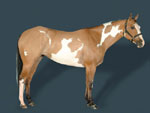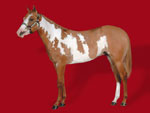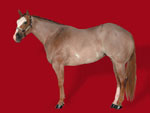While the colorful coat pattern is essential to the identity of the breed, American Paint Horses have strict bloodline requirements and a distinctive stock-horse body type. To be eligible for registry, a Paint's sire and dam must be registered with the American Paint Horse Association, the American Quarter Horse Association, or the Jockey Club (Thoroughbreds). At least one parent must be a registered American Paint Horse. To be eligible for the Regular Registry, the horse must also exhibit a minimum amount of white hair over unpigmented (pink) skin.
Markings can be any shape or size, and located virtually anywhere on the Paint's body.
Although Paints come in a variety of colors with different markings, there are only three
specific coat patterns: tobiano, overo and tovero.
These colors, markings and patterns, combined with stock-type conformation, athletic ability
and agreeable disposition, make the American Paint Horse an investment in quality.
COLOR PATTERNS:
Tobiano (pronounced: tow be yah' no)
The dark color usually covers one or both flanks.
Generally, all four legs are white, at least below the hocks and knees.
Generally, the spots are regular and distinct as ovals or round patterns that
extend down over the neck and chest, giving the appearance of a shield.
Head markings are like those of a solid-colored horse--solid, or with a blaze, strip, star or snip.
A tobiano may be either predominantly dark or white.
The tail is often two colors.
Overo (pronounced: oh vair' oh)
The white usually will not cross the back of the horse between its withers and its tail.
Generally, at least one and often all four legs are dark.
Generally, the white is irregular, and is rather scattered or splashy.
Head markings are distinctive, often bald-faced, apron-faced or bonnet-faced.
An overo may be either predominantly dark or white.
The tail is usually one color.
Tovero (pronounced: tow vair' oh)
Dark pigmentation around the ears, which may expand to cover the forehead and/or eyes.
One or both eyes blue.
Dark pigmentation around the mouth, which may extend up the sides of the face and form spots.
Chest spot(s) in varying sizes. These may also extend up the neck.
Flank spot(s) ranging in size. These are often accompanied by smaller spots that extend forward across the barrel, and up over the loin.
Spots, varying in size, at the base of the tail.
COAT COLORS:
Black
entire coat, including muzzle, flanks and legs, are black; color may fade when exposed to the sun; could have rusty tinge during certain times of the year; early foals may be an overall mousy gray, then shed to black.
Brown
body color brown or black, with light areas at muzzle, eyes, flank and inside upper legs; mane and tail usually black.
Bay
body color reddish brown, with variations ranging from dark blood bay to light bay and usually distinguished by black mane and tail, ear tips, lower legs.
Bay Roan
the overall intermingling of white hairs with bay body color; head, lower legs, mane and tail are usually solid or darker; does not get progressively whiter with age.
Blue Roan
the overall intermingling of white hairs with a black body color, head, lower legs, mane and tail are usually solid or darker; does not get progressively whiter with age.
Buckskin
body color yellowish or gold, mane and tail black; black on lower legs; lacks primitive markings.
Dun
diluted body color of yellowish or gold; mane and tail are black or brown; has dorsal stripe and usually zebra stripes on legs and transverse stripe over withers.
Gray
dominant over all other color genes; born any color with white hair progressively turning the coat whiter as the horse ages; dark skin; normally grays first around eyes and behind ears.
Grullo
a form of dun with body color smoky or mouse-colored (not a mixture of black and white hairs, but each hair mouse-colored); mane and tail black; has black primitive markings.
Perlino
double dilute of bay/brown resulting in body color of cream or off-white, lower legs, mane and tail light rust or chocolate shade; skin is pinkish or gray; eyes are blue or amber; the coat has enough yellow hue to allow white markings to be visible.
Chestnut
body color dark red or brownish red; range from very light to liver chestnut; liver chestnut can be distinguished from black or brown only by the bronze or copper highlights on the legs; mane and tail usually dark red or brownish red, but may be flaxen.
Cremello
double dilute of chestnut/sorrel resulting in body color, mane and tail of cream or off-white with pale pinkish skin; the coat has enough yellow hue to allow white markings to be visible; eyes are blue or amber
Palomino
diluted body color varying from rich gold to pale yellow; mane and tail generally pale or off-white but may be same color as body (with nonblack points).
Red Dun
a form of dun with body color yellowish or flesh-colored; mane and tail are red or reddish; has red or reddish primitive markings.
Red Roan
the overall intermingling of white hairs with chestnut/sorrel body color; head, lower legs, make and tail are usually sorrel or dark red; does not get progressively whiter with age.
Sorrel
body color reddish or copper-red; mane and tail usually same color as body, but may be flaxen or very dark brown.


























